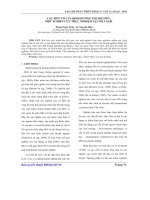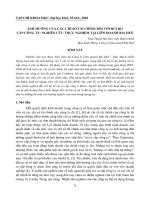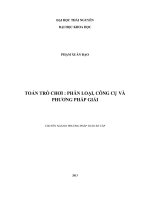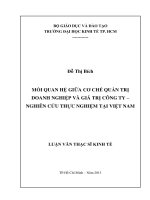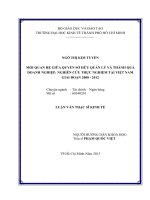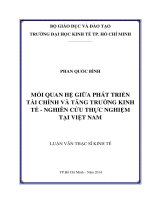Phân loại học sinh và phương pháp dạy học sinh ở lớp học có học sinh khác nhau về kiểu trí thông minh – một nghiên cứu thực nghiệm tại một trường tiểu học ở hà nội
Bạn đang xem bản rút gọn của tài liệu. Xem và tải ngay bản đầy đủ của tài liệu tại đây (1.17 MB, 67 trang )
VIETNAM NATIONAL UNIVERSITY, HANOI
UNIVERSITY OF LANGUAGES AND INTERNATIONAL STUDIES
FACULTY OF POST-GRADUATE STUDIES
LƯU THỊ MAI THANH
DIFFERENTIATED INSTRUCTION FOR STUDENTS
OF DIFFERENT INTELLIGENCES – AN EXPERIMENTAL STUDY
AT A PRIMARY SCHOOL IN HANOI
(Phương pháp dạy học phân loại học sinh theo những kiểu
trí thông minh khác nhau – một nghiên cứu thực nghiệm tại một
trường tiểu học ở Hà Nội.)
M.A. MINOR PROGRAMME THESIS
Field: English Language Teaching Methodology
Code: 8140231.01
HANOI, 2018
VIETNAM NATIONAL UNIVERSITY, HANOI
UNIVERSITY OF LANGUAGES AND INTERNATIONAL STUDIES
FACULTY OF POST-GRADUATE STUDIES
LƯU THỊ MAI THANH
DIFFERENTIATED INSTRUCTION FOR STUDENTS
OF DIFFERENT INTELLIGENCES – AN EXPERIMENTAL STUDY
AT A PRIMARY SCHOOL IN HANOI
(Phương pháp dạy học phân loại học sinh theo những kiểu
trí thông minh khác nhau – một nghiên cứu thực nghiệm tại một
trường tiểu học ở Hà Nội.)
M.A. MINOR PROGRAMME THESIS
Field: English Language Teaching Methodology
Code: 8140231.01
Supervisor: Dr. Nguyễn Thị Ngọc Quỳnh
HANOI, 2018
TABLE OF CONTENTS
DECLARATION..........................................................................................................................................i
ACKNOWLEDGEMENTS..........................................................................................................................ii
ABSTRACT...............................................................................................................................................ii
LIST OF ABBREVIATIONS........................................................................................................................iii
LIST OF TABLES AND FIGURES...............................................................................................................iv
PART 1: INTRODUCTION.........................................................................................................................1
1. Rationale.............................................................................................................................................1
2. Objectives...........................................................................................................................................4
3. Subjects..............................................................................................................................................4
4. Research questions............................................................................................................................5
5. Methodology......................................................................................................................................5
6. Organization of the thesis..................................................................................................................6
PART 2: DEVELOPMENT..........................................................................................................................7
CHAPTER 1: LITERATURE REVIEW..........................................................................................................7
1.1.Intelligence...................................................................................................................................7
1.1.1.Different views of intelligence..............................................................................................7
1.1.2.The theory of Multiple Intelligences....................................................................................9
Figure 1. Multiple intelligence domains by McKenzie (2002, p. 156)................................................14
1.1.3.Critiques of Multiple Intelligence Theory..........................................................................14
1.2.Differentiated instruction..........................................................................................................15
1.2.1.Mixed ability classrooms....................................................................................................15
1.2.2. Differentiated instruction..................................................................................................16
1.3.Experimental research...............................................................................................................17
CHAPTER 2: RESEARCH METHODOLOGY.............................................................................................18
2.1. The setting of the study:...........................................................................................................18
2.1.1. A description of the students and their learning program:..............................................18
2.1.2. A description of the teachers:...........................................................................................18
2.2. Research methodology:............................................................................................................19
2.2.1. Participants:.......................................................................................................................19
2.2.2. The instruments:................................................................................................................20
Table 1. Reliability Statistics of Multiple Intelligences survey............................................................21
2.3. Procedures:...............................................................................................................................24
2.4. Statistics:...................................................................................................................................25
2.5. Data Analysis.............................................................................................................................26
CHAPTER 3: FINDINGS AND DISCUSSION............................................................................................27
3.1. Scores of multiple intelligence survey......................................................................................27
Figure 2. Distributions of multiple intelligences.................................................................................27
Figure 3. Mean scores of MI preferences............................................................................................28
Figure 4. Mean scores and Standard deviation of MI frequencies.....................................................28
3.2. The results of pre-test and post –test......................................................................................29
Figure 5: Paired samples statistics of Class 1......................................................................................30
Figure 6. A score comparison between pre-test and post-test of Class 1..........................................30
Figure 7. Paired samples statistics of Class 2.......................................................................................30
Figure 8. A score comparison between pre-test and post-test of Class 2..........................................31
3.3. The result of interviews............................................................................................................32
3.4. Implications...............................................................................................................................33
PART III: CONCLUSION..........................................................................................................................35
REFERENCES.........................................................................................................................................39
..............................................................................................................................................................39
APPENDIX................................................................................................................................................I
APPENDIX 1: MULTIPLE INTELLIGENCE SURVEY.....................................................................................I
APPENDIX 3 – TEST SCORES..................................................................................................................III
APPENDIX 4: SAMPLE OF DIFFERENTIATED LESSON PLANS................................................................IV
APPENDIX 5 – A TYPICAL ACTIVITY FOR STUDENTS WITH NATURALISTIC INTELLIGENCE..................VI
APPENDIX 6 – A TYPICAL ACTIVITY FOR STUDENTS WITH MATHEMATICAL INTELLIGENCE..............VII
APPENDIX 7 – A TYPICAL ACTIVITY FOR STUDENTS WITH VERBAL INTELLIGENCE...........................VIII
APPENDIX 8 – A TYPICAL ACTIVITY FOR STUDENTS WITH MUSICAL INTELLIGENCE..........................IX
APPENDIX 9 – A TYPICAL ACTIVITY FOR STUDENTS WITH VISUAL INTELLIGENCE...............................X
APPENDIX 10 – A TYPICAL ACTIVITY FOR STUDENTS WITH BODILY INTELLIGENCE............................XI
APPENDIX 11 – A TYPICAL ACTIVITY FOR STUDENTS WITH INTERPERSONAL INTELLIGENCE...........XII
APPENDIX 13: INTERVIEW FORM.......................................................................................................XIV
APPENDIX 14: OBSERVATION FORM...................................................................................................XV
APPENDIX 15: MI GROUPS CLASSIFIED BY THE..................................................................................XVI
MOST DOMINANT INTELLIGENCES....................................................................................................XVI
DECLARATION
I certify that the thesis is the result of my own research and the
substance of the thesis has not, wholly or in part, been submitted for a degree
to any other university or institution. Where other sources of information have
been used, they have been indentified and acknowledged.
Hanoi, December 2018
Luu Thi Mai Thanh
i
ACKNOWLEDGEMENTS
First and foremost, I would like to send my deepest gratitude to my
supervisor, Dr. Nguyen Thi Ngoc Quynh for her helpful suggestions,
comments and continuous support of my study. I am also grateful to her for
reading my manuscript and helping me make necessary changes.
I would also like to all of the members in Post-graduate Department of
University of Languages and International Studies (Hanoi) for designing a
very useful syllabus of my Master program.
Finally, I would like to express my gratitude to my parents and my
husband for their continuous support and encouragement throughout my
study time.
Hanoi, December 2018
Luu Thi Mai Thanh
ii
ABSTRACT
According to Ellis (1985) second language learners are different in
speed and results. So the purpose of this study was to find the best way for
teachers to cater much better for every single student. The research
investigated Gardner’s “Theory of multiple intelligences” in a sample of forty
eight students and they were all in grade four at a primary school in Hanoi.
This research is an experimental study with the target group. The instruments
included multiple intelligence survey form; typical activities for different
multiple intelligence types; one pre-test and one post-test; interviews and
observations. The one experiment group design was used with subject.
Meanwhile, percentage and index were used to analyze the collected data.
There is a variety of learning activities created to develop students in all
aspects.
Keywords: intelligence, multiple intelligences, differentiated instruction
ii
LIST OF ABBREVIATIONS
MI:
Multiple intelligence(s)
SPSS:
Statistical Package for Social Science
iii
LIST OF TABLES AND FIGURES
Figure 1. Multiple intelligence domains by McKenzie (2002, p. 156)................................................14
Table 1. Reliability Statistics of Multiple Intelligences survey............................................................21
Figure 2. Distributions of multiple intelligences.................................................................................27
Figure 3. Mean scores of MI preferences............................................................................................28
Figure 4. Mean scores and Standard deviation of MI frequencies.....................................................28
Figure 5: Paired samples statistics of Class 1......................................................................................30
Figure 6. A score comparison between pre-test and post-test of Class 1..........................................30
Figure 7. Paired samples statistics of Class 2.......................................................................................30
Figure 8. A score comparison between pre-test and post-test of Class 2..........................................31
iv
PART 1: INTRODUCTION
This chapter introduces the research area and outlines the background
and rationale for the present study. It also provides a chapter by chapter
overview of the thesis.
1. Rationale
Differentiation seems to have become a very familiar term that many
teachers have heard. However, it can be difficult to define. The concept comes
from the idea that there are a large number of children with mixed abilities in
classes, and those activities are needed to be varied based on student’s levels
of understanding, readiness to learn, learning needs, or interest.
According to BBC active (2010), differentiation is defined by the
Training and Development Agency (TDA) for schools as “the process by
which differences between learners are accommodated so that all students in a
group have the best possible chance of learning”. In recent decades, it has
been considered as a key skill for any teacher, especially those with mixed
ability classes.
However, according to Stradling and Saunders (1993), differentiation is
a pedagogical, rather than an organizational approach. Differentiation shapes
an approach to teaching in which teachers proactively modify curricula,
teaching methods, resources, learning activities, and student products. This is
done to address the diverse needs of individual students and small groups of
students, and to maximize the learning opportunity for each student in a
classroom (Berne, 1999; Tomlinson, 1999).
When teachers follow differentiated instruction, they become
instructors, not speakers in the class. Therefore, they give their students a
higher chance of practicing and sharing their ideas in every lesson. Thus,
there is a close relationship between the differentiation approach and the
1
learner – centred class theory.
Jean Jacque Rousseau (1712-1778), a Swiss born French theorist confirmed
that teachers should begin an instruction by considering what the learner is
capable of learning, and what he is interested in learning. The learner-centred
approach is therefore strongly advocated, based on the conviction that all are
capable of learning and enhancing self-development to their highest potential.
There exists a very popular saying: “Everybody is a genius. But if you
judge a fish by its ability to climb a tree, it will live its whole life believing
that it is stupid.” This saying is frequently misquoted as Albert Einstein,
however, I believe it is a great quote. In fact, there are a lot of teachers who
have been using the same activities for different students in a class and
evaluate them with the same criteria. The research which I have focused on
has since made me reflect on my own teaching in my classroom. Thus, I have
been asking myself: “Have I considered my students’ needs before teaching?
Have I given them equal evaluations and opportunities?”
Mixed ability classes are widespread among schools, even though
students in Vietnam are tested, and organised and grouped on academic
ability. However, this is based on their first language, rather than in English.
Therefore, a wide range of abilities is a common occurrence in many
classrooms, and one that many teachers are struggling with in our own
staffroom. This has enhanced my own reflections: “How do I meet the needs
of all my students?” Teachers are aware, more than ever, that a one-size-fitsall lesson plan will not meet the needs of all their learners.
In the paper named “Teaching English in Primary Schools in Vietnam”
(2007), Dr. Nguyen Mai Hoa introduced Moon’s (2005) finding of the
teaching methodology.
Moon (2005) pointed out that in many primary
schools the teaching methods are “adult-oriented”. In my experience, one of
the most dominant features of teaching methodology used in ESL is
2
repetition. This is done through drills and whole class choralling. This is
meant to help children to learn vocabulary and grammar word perfectly. And
this context is not fair to all of students. In fact, students come with varied
backgrounds, home life, experiences, motivation and abilities, not to mention
different learning styles. While teachers are aware of this phenomenon, they
are often unsure how to deal with it (Tobin & McInnes, 2008). If educational
practice is to progress teachers need to find a way to deal with diversity and
the needs of individuals, while teaching a group of students (Visser, 1998).
In my personal experience, the greatest satisfaction that an instructor
can have each time students come out of their class is that they gain an
understanding of the lesson and an appreciation of their teacher. However, in
a classroom with many students of different levels of knowledge, skill and
attitude, this is quite difficult. How do we ensure that we are applying a
suitable teaching strategy and a proper assessment method to detect learning?
To answer this question, we should build an ideal learning environment where
students are eager to learn and express their ideas confidently.
I have taught English to primary students at a big school in Hanoi for
nine years. This is a private school where students have seven English classes
per week. During this time, I worked very hard and tried my best to update
useful teaching methods. I have noticed a tremendous difference in ability in
each of groups of students. This diversity, added to the amount of exposure to
English via multimedia outlets, interests, and learning styles, all play a role in
the vast ability gap in English among students. I quickly came to realize that it
is better to have a variety of text levels available, as well as assignments.
As a way to differentiated instruction, a teacher may implement the
theory of multiple intelligences (MI). The theory was developed by Howard
Gardner in the early 1980s and states that each person has several distinct
intelligences correlating with a specific part of the brain. Utilizing the MI
3
theory, teachers can organize learning activities to be relevant each of the
intelligences in their classrooms. This means that students will have targeted
learning experiences, resulting in higher levels of achievement. The theory of
MI recommended that teaching strategies for a group of children may not be
suitable for another group.
2. Objectives
This research presents the effect of a new teaching strategy
“Differentiated instruction for students of different intelligences” with the
hope of caring for every student in a class. So it will help teachers to organize
class activities in a more effective way and improve the present situation by
unleashing students’ sleeping potentials. This experimental study also gives a
meaningful answer to the question “How do I meet the needs of all my
students?” The objective totally matches one of the purposes of teaching
English as an elective subject in primary schools: “Building positive attitudes
to English, and better understanding and love for Vietnamese through learning
English. Furthermore, students’ intelligence, personality, and learning method
will have also been gradually formed” (Ministry of Education and Training,
2003).
The research aims to build up motivations for the students in their
learning progress. So that a variety of activities designed for different groups
will be organized in every lesson.
All of the students who took part in the study can be informed about
what their dominant intelligence(s) are so that they can adjust their learning
strategies to get improvement. Hence, this research one more time confirms
the statement: “Everybody is a genius.”
3. Subjects
The research was conducted on two Grade 4 classes in a primary school in
Ha Noi. The participants were an English teacher who had more than nine
years of teaching experience and twenty four students from Class 1, twenty
4
four students from Class 2. “Everybody up 4” (second edition) published by
Oxford University Press (2016) was used as the textbook.
The teacher first had the students do a multiple intelligence survey to
identify their intelligence types, and then designed lesson plans which
included different activities for different groups of students to cater their
needs effectively. A pre-test and post-test will also be given to compare the
students’ performances of these two classes.
4. Research questions
In order to find out the impact of multiple intelligence theory on
student’s achievement, this study was designed to answer two questions:
a. What are students’ types of intelligences?
b. To what extent does the differentiated lessons based on the application of
the MI theory lead to better learning by the students?
5. Methodology
The study consists of three phases. The first phase focuses on MI survey
and answers Research question 1. The second phase mainly carries out
differentiated lessons. And in the third phase, the research aims to judge
students’ achievement and analyze data. This is an experimental study with
the use of the following instruments:
•
•
•
•
A multiple intelligence survey for students.
A pre-test and post-test.
Interviews for students.
Differentiated activities based on the theory of multiple intelligences.
A printed MI survey created by Laura Candler (2011) was used in the
study because most other MI surveys are too long or complex for kids. It was
then translated into Vietnamese so that students could read and answer easily.
The teacher delivered the survey during the teaching time and had the
students finish it in one period. The next day, gathered data were analyzed
with the software named Statistical Package for Social Science (SPSS) to
5
ensure the validity and reliability.
In this case, Class 1 was the experimental group, and Class 2 was the
control group. A list of varied activities was designed in every lesson to
enhance the potential of each child. After analyzing data, interviewing
students and observing lessons, the researcher made any adjustments to the
instruments and the method of teaching if needed. A pre-test and post-test
were also conducted to find out how the students in each of the group had
made improvements in English subject.
6. Organization of the thesis
This study covers three main parts as follows:
Part 1: Introduction
This part consists of rationale, objectives, scope, research questions,
methodology and organization of the study.
Part 2: Development
Chapter 1 covers the theoretical background relevant to the study.
Chapter 2 presents experimental research and also describes the current
situation of teaching and learning at this school, subjects of the study, data
collection instruments, data collection and analysis procedures.
Chapter 3 shows the analyzed findings and answers for two research
questions.
Part 3: Conclusion
This part is considered as a brief summary of the main content including
in the study. It is also a recapitulation of findings, and it discusses on some
limitations of the study as well as gives out suggestions for further study.
6
PART 2: DEVELOPMENT
CHAPTER 1: LITERATURE REVIEW
This chapter aims to establish the significance of the general field of
the study, then identify a place where a new contribution of MI could be
made. The bulk of the chapter was on critically evaluating the different views
of “intelligence” so as to identify the appropriate approach to investigate the
research questions.
1.1.
Intelligence
1.1.1. Different views of intelligence
The term “intelligence” has many definitions, taking into account its
complexity. The notion of general intelligence (Spearman, 1927) had long
been widely accepted by psychologists. Historically, for a long time,
intelligence quotient (IQ) test had been used as an effective instrument to
identify the intellectual ability of someone. The abbreviation “IQ” was
invented by the psychologist William Stern in 1912. Many different kinds of
IQ tests included varied items. Some test items are visual, while some are
verbal. In 1904, Charles Spearman made the first formal factor analysis
correlations among the tests. He named “g” for “general factor”, and it was an
important tool of an IQ test. However, Howard Gardner noted in his book
“Frame of mind” that the IQ tests had predictive power for success in
schooling but little predictive power when it came outside the school context.
Because of the important role in language learning, a lot of researchers have
given different definitions for intelligence.
According to Wagner and Sternberg (1985), there were three
conceptions of intelligence. These views were reviewed by Chastain in a book
written in 1988. Firstly, from the psychometric view, intelligence is defined as
7
mental capacity, and prepared tests can be used carefully to measure that
mental ability. After measuring, the test results can help in ranking learners
according to their ability. Secondly, from the Piagetian view, he believes that
intelligence is composed of stages of development based on maturity,
experiences in the physical environment, and it is the product of individual
self-regulator processes. Thirdly, the information processing view points out
that intelligence comes from the way the brain represents and processes
information.
In Moaafian’s point of view (2008, cited in Hernandez et al., 2010),
intelligence is a person’s ability to reason, plan, solve problems, understand
complex ideas, learn quickly and learn from experience. In short, intelligence
in this view is considered as a very general mental capacity, it is like some of
personal competences in both schooling and non-schooling environments.
Ellis (2008) confirmed that there was a close link among intelligence,
working memory and language aptitude. With this view, Ellis also mentioned
cognitive capacities and the difference between their conceptualizations and
terms (p.649).
Howard Gardner (2011, p.63) appreciated that his review of earlier
studies of intelligence suggested him the existence of different intellectual
strengths/competences. Gardner (1983,p.81) defined “intelligence as the
ability to solve problem or to create fashion products that are valued within
one or more cultural settings”. This definition showed the difference between
his idea and the traditional psychology view of intelligence. Furthermore,
Gardner (1993) described intelligence as a bio-psychological potential that
could be changed by motivational, experience and culture factors. And in the
book entitled “Multiple intelligences around the world” (p.323), he pointed
out that intelligence was “a set of skills of problem-solving” helping a person
8
deal with his/ her problems or difficulties. Also, intelligence was “the
potential for finding or creating problems – thereby laying the groundwork for
the acquisition of new knowledge”.
Looking back at the above definitions of intelligence, I find that
Spearman, Piaget, Moaafian and Ellis just limited intelligence in one or some
of the aspects and “intelligence” is uncountable. Meanwhile, Gardner made
the term “intelligence” become a countable noun, and he has professed to be
quite willing to refer to his eight intelligences as talents or abilities. He
claimed that there was no hierarchy of ability, and Linguistic and Logical/
Mathematical abilities are not more important than any of the other
“intelligences” in real-life.
1.1.2. The theory of Multiple Intelligences
1.1.2.1.
Types of multiple intelligences
The theory of multiple intelligences was coined by Howard Gardner in his
book named “Frames of mind” (1983). Gardner uses the term MI to explain
the different ways in which people are intelligent. He proposes that learners
have seven types of intelligences. Each of us has these intelligences, but there
are some intelligences that are much more dominant than others. This view on
intelligence differs from the before views which based on only two
intelligences: Linguistic and Mathematical intelligence. The theory helps
teachers comprehend better how individual strengths can be understood.
Gardner (1983) identified seven categories of skills and abilities which he
considered as individual intelligences: linguistic, logical-mathematical,
spatial, bodily-kinesthetic, musical, interpersonal and intrapersonal. Later he
added two more types: naturalistic intelligence (1995) and existential
intelligence (1999). Educational researchers has made further studies on the
hypothesis of existential intelligence for years, so that the teacher did not put
9
this type in practice. Gardner (1993) claims that all intelligences are needed in
society, and seven types of intelligences could be used together in a learning
environment. I totally appreciates this idea and plans to give students chances
of using their preferred intelligences in their classroom.
The theory of MI had been proposed, discussed and developed in four
books: “Frames of mind: The theory of multiple intelligences” (1983),
“Multiple intelligences” (1993), “Intelligence reframed: Multiple intelligences
for the 21st century” (1999) and “Multiple intelligences around the world”
(2009). Parviz Maftoon exploited these ideas in the series and made very clear
descriptions for all intelligences in an article named “The Realization of
Gardner’s Multiple Intelligences (MI) Theory in Second Language
Acquisition (SLA)” (pp. 1235-1236). Furthermore, his review turned to be
very helpful for language instructors since it provided some suggested
activities which were suitable for students of specific types of intelligences.
What follows is a brief introduction of
intelligence types shorten from
Maftoon’s article.
a. Verbal/ Linguistic Intelligence
A person who owns this intelligence has the ability of applying linguistic
rules effectively. He or she is very sensitive to language and able to deal with
problems by using language. Gardner (1993) pointed out that poets, linguists,
language teachers, lawyers...are the one who possess verbal/ linguistic
intelligence. A student who has this type of intelligence might be eager to do
the following activities:
b.
Visiting libraries or bookstores.
Writing diaries.
Playing word games.
Memorizing songs, poems or stories.
Logical/ Mathematical intelligence
10
According to Gardner (1993), students with logical/mathematical
intelligence are keen on the processes of categorization, classification,
inference, generalization, calculation and hypothesis testing. They are good at
doing comprehension/ written language tests. Suggested activities for these
students might be:
c.
Watching videos about science.
Finding out information about famous scientists’ inventions.
Visiting science museums.
Arranging things into story line or time line.
Visual/ Spatial intelligence
This type of intelligence refers to the sensitivity to colors, shapes, lines,
forms and space. A person who has spatial intelligence is good at visualizing
models in detail . He or she is interested in the following things while learning
a language:
d.
Working on puzzles with words.
Making a collage by cutting out images from newspapers/ magazines...
Making films.
Watching advertisements/films/ videos...
Musical intelligence
Musical intelligence can help students to adjust accent and pitch within
language learning. They like to listen to music or sing and chant. If students
have this type of intelligence, they seem to focus on doing the following
activities:
e.
Burning a CD of their favorite songs.
Singing songs.
Going to concerts or listening to music.
Bodily/ Kinesthetic intelligence:
Bodily/ Kinesthetic intelligence is the ability of using body for
expression. It also refers to the use of body in dealing with problems or
making products. People having this type of intelligence might choose jobs
such as athletes, dancers, mechanics, and physical education teachers. A
11
student with bodily intelligences likes doing the following activities:
f.
Involving in sports.
Signing up for drama or dancing class.
Miming or acting out a story.
Gardening, cooking, learning car mechanics.
Interpersonal intelligence
This type of intelligence expresses the ability to getting on well with
human relationships. People that possess interpersonal intelligence are
teachers, salesperson, or politicians. In Teele’s (2000) view, interpersonal
intelligence individuals are very friendly and eager to participate in social
activities. They prefer doing the following activities:
- Interacting with other people.
- Being a people watcher and looking for chances of practicing English.
- Taking part in some clubs, parties... and talking to people that they do
not know well.
g. Intrapersonal intelligence:
Intrapersonal intelligence makes a person independent, appreciate time
alone and be self-reflective. He or she can define interests, fears and abilities.
Self-monitoring becomes the most dominant characteristics of these
individuals. Students who own this type of intelligence may like doing the
following activities:
h.
Thinking their goals and their hopes for the future.
Using a diary to write about their thoughts and feelings.
Making a list of strengths and weaknesses of their language learning.
Naturalistic intelligence:
Gardner added this intelligence as the eighth one after the first publication
of the model in 1995. Gardner (1999) pointed out that a naturalist is the one who
is good at identifying and classifying objects. People who own this type of
intelligence always focus on “observing, classifying and understanding the parts
of the physical environment as well as showing understanding of natural
12
phenomena” (Parviz Maftoon, p.1236). A student who has naturalistic
intelligence is usually concerned with the following activities:
- Discovering environment, animals, nature and plants.
- Talking about favourite pets or natural places to classmates, friends,
parents...
With the hope of cater for all of students’ needs, it is important when
looking at how students possess different kinds of minds, and therefore learn,
remember, perform, and understand in different ways. Gardner argued that
students would be better served if teachers could teach in a number of ways
and learning could be assessed through a variety of means. In term of
teaching, this theory makes wonderful changes for teachers’ method. A
teacher-centred class really shifted to a learner-centred class by various
activities in the lessons. The researcher highly appreciates lists of suggested
activities for students given by Howard Gardner. The theory of Multiple
Intelligences (MI) brings a magic door for differentiated instruction, and it is
also the reason why this paper mentioned the term MI.
1.1.2.2. Three domains of multiple intelligences
McKenzie (2002) categorized three domains of multiple intelligences:
the analytical, introspective and interactive domains (Figure 1).
13
Figure 1. Multiple intelligence domains by McKenzie (2002, p. 156)
McKenzie grouped logical, musical and naturalist intelligence into the
analytic domain because they include the processes of analyzing and
incorporating data into existing schema. The interactive domain consists of
linguistic, interpersonal and kinesthetic intelligence because the students who
have these types of intelligences typically invite and encourage interaction to
achieve understanding. Intrapersonal, existential and visual intelligence
belong to the introspective domain because they need a looking inward
learners, an emotive connection to their own experiences and beliefs to make
sense of new learning .
These domains show the relationship among some types of
intelligences and teachers can depend on this classification to plan lessons
that address all of the intelligences in a class. The domain also might help
teachers to minimize the number of groups in a lesson.
1.1.3. Critiques of Multiple Intelligence Theory
Gardner (2011, p.293) discussed on a critique of the MI theory by
himself. He pointed out that there were still numerous areas of human
psychology that the theory could not encompass. Before that, some other
researchers have concentrated on the problems with the theory.
Carroll (1985) thought that Gardner might have neglected the area of
memory as psychometric evidence which shows the important abilities in this
domain.
Many psychologists (for example, Klein, 1988, p.106) see that
differentiation of the concept of intelligence is not supported by well-founded
evidence. However, many educationalists appreciate the practical value of the
strategies suggested by the theory.
Steinberg (1988) argues that Gardner is not supporting the existing
definitions of “intelligence”, and in fact he uses the word “intelligence” with
14
the same meaning of “ability”. So that he calls MI theory as “a theory of
talents, not one of intelligences”.
However, the theory is also received support from many researchers
and educators. MI theory is evaluated its results by its applications in
educational settings (Chen, 2004). For instance, Project Zero at Harvard
University studied forty-one schools that applied MI theory to their
curriculum for three school years. The results showed improvements in
students’ test scores and discipline, parents’ involvement. Haley (2004) also
appreciated the effectiveness when applying MI theory to second language
and foreign language learning and teaching.
1.2.
Differentiated instruction
1.2.1. Mixed ability classrooms
Mixed ability classrooms are widespread among schools. This is a
common factor that teachers have been struggling with, and asking the
question that triggered this study: “How do I meet the needs of all my
students?” Teachers are aware, more than ever, that a one-size-fits-all lesson
plan will not meet the needs of all their learners. Students come with varied
backgrounds, home life, experiences, motivation and abilities, not to mention
different learning styles. While teachers are aware of this phenomenon, they
are often unsure how to deal with it (Tobin & McInnes, 2008).
The greatest satisfaction that a lecturer can have is that each time
students come out of class they strongly impress on their lesson and
appreciate the lecturer as the best one they have got in their life. However, in
a classroom with many students of different knowledge backgrounds, skills
and attitude, this value is quite difficult to get. How do teachers ensure that
they are applying suitable teaching strategies and a proper assessment method
to detect learning? To answer this question, educators should build an ideal
15

